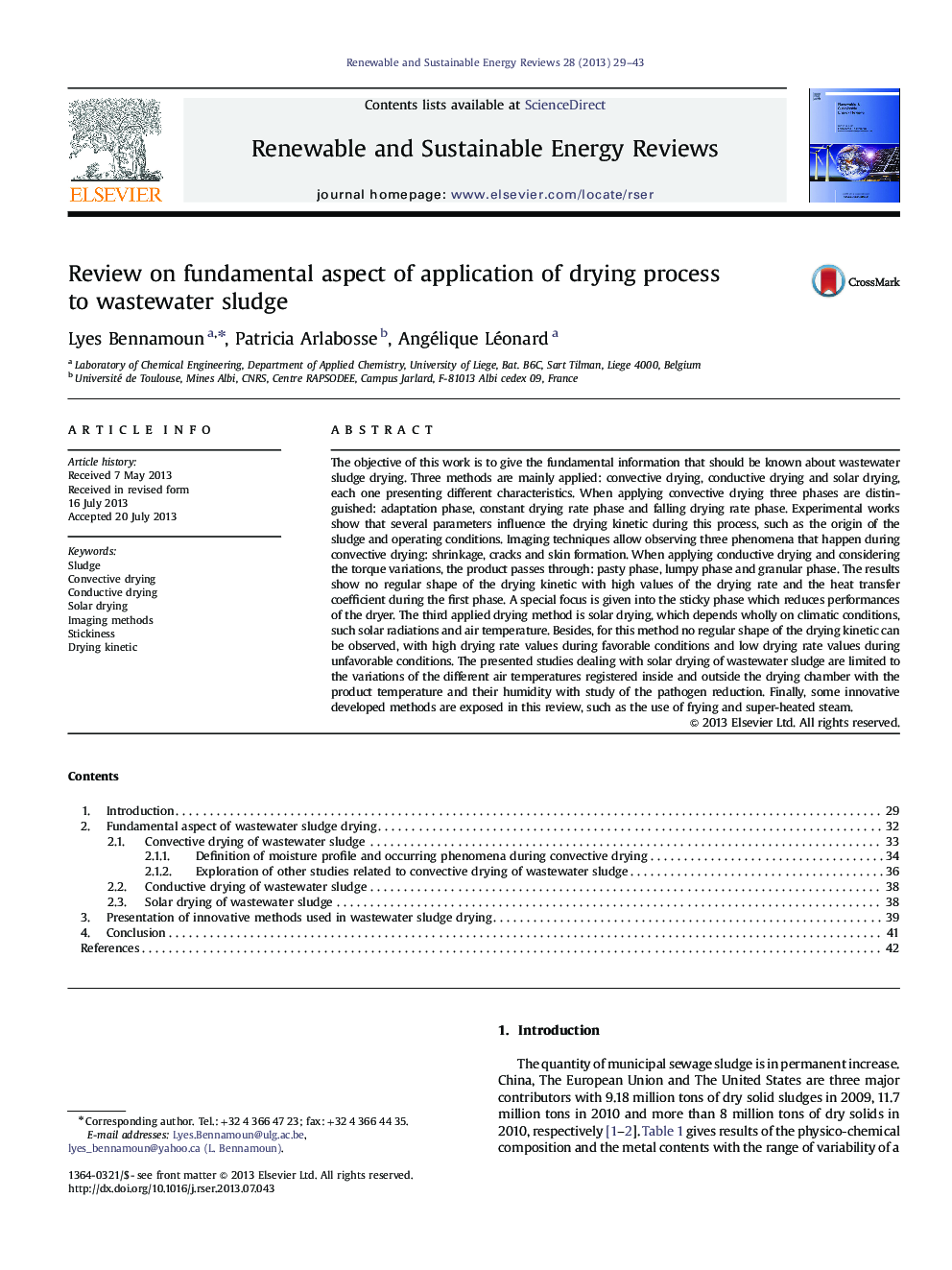| کد مقاله | کد نشریه | سال انتشار | مقاله انگلیسی | نسخه تمام متن |
|---|---|---|---|---|
| 8120812 | 1522357 | 2013 | 15 صفحه PDF | دانلود رایگان |
عنوان انگلیسی مقاله ISI
Review on fundamental aspect of application of drying process to wastewater sludge
ترجمه فارسی عنوان
بررسی جنبه های اساسی استفاده از فرایند خشک کردن به لجن فاضلاب
دانلود مقاله + سفارش ترجمه
دانلود مقاله ISI انگلیسی
رایگان برای ایرانیان
کلمات کلیدی
لجن، خشک شدن هم انعطاف پذیر، خشک کردن هدایت، خشک کردن خورشیدی، روش های تصویربرداری، چسبندگی، خشک کردن جنبشی،
ترجمه چکیده
هدف از این کار ارائه اطلاعات اساسی است که باید درباره خشک شدن لجن فاضلاب شناخته شود. سه روش عمدتا استفاده می شود: خشک کن کن، خشک کردن هدایت و خشک شدن خورشید، هر کدام ویژگی های مختلفی دارند. هنگام استفاده از خشک شدن کانتینر سه فاز مشخص می شود: فاز انطباق، فاز سرعت خشک شدن ثابت و فاز سرعت خشک شدن. کارهای تجربی نشان می دهد که چندین پارامتر در طی این فرایند، مانند منشاء لجن و شرایط عملیات، به جنبش خشک شدن تاثیر می گذارند. تکنیک های تصویربرداری اجازه می دهد رعایت سه پدیده ای که در طول خشک کردن کنتراست اتفاق می افتد: انقباض، ترک و شکل گیری پوست. هنگام استفاده از خشک شدن رسانا و با توجه به تنوع گشتاور، محصول عبور می کند: فاز خمیری، فاز توده ای و فاز دانه ای. نتایج نشان می دهد که به طور منظم سینتیک خشک کردن با مقدار بالا میزان خشک شدن و ضریب انتقال حرارت در فاز اول وجود ندارد. تمرکز ویژه ای در فاز چسب دار که باعث کاهش عملکرد خشک کن می شود. سومین روش خشک کردن خشک شدن خشک است که به طور کامل بستگی به شرایط آب و هوایی، مانند اشعه خورشیدی و دمای هوا دارد. علاوه بر این، برای این روش، شکل منظم سینتیک خشک شدن را نمی توان مشاهده کرد، با نرخ های خشک شدن بالا در شرایط مطلوب و نرخ خشک شدن خشک در شرایط نامطلوب. مطالعات ارائه شده در مورد خشک شدن خورشید لجن فاضلاب محدود به تغییرات دمای هوا مختلف در داخل و خارج اتاق خنک کننده با دمای محصول و رطوبت آن با مطالعه کاهش آسیب پذیر است. در نهایت، برخی از روش های نوآورانه توسعه یافته در این بررسی، مانند استفاده از سرخ کردن و بخار سوپر گرم، در معرض قرار می گیرند.
موضوعات مرتبط
مهندسی و علوم پایه
مهندسی انرژی
انرژی های تجدید پذیر، توسعه پایدار و محیط زیست
چکیده انگلیسی
The objective of this work is to give the fundamental information that should be known about wastewater sludge drying. Three methods are mainly applied: convective drying, conductive drying and solar drying, each one presenting different characteristics. When applying convective drying three phases are distinguished: adaptation phase, constant drying rate phase and falling drying rate phase. Experimental works show that several parameters influence the drying kinetic during this process, such as the origin of the sludge and operating conditions. Imaging techniques allow observing three phenomena that happen during convective drying: shrinkage, cracks and skin formation. When applying conductive drying and considering the torque variations, the product passes through: pasty phase, lumpy phase and granular phase. The results show no regular shape of the drying kinetic with high values of the drying rate and the heat transfer coefficient during the first phase. A special focus is given into the sticky phase which reduces performances of the dryer. The third applied drying method is solar drying, which depends wholly on climatic conditions, such solar radiations and air temperature. Besides, for this method no regular shape of the drying kinetic can be observed, with high drying rate values during favorable conditions and low drying rate values during unfavorable conditions. The presented studies dealing with solar drying of wastewater sludge are limited to the variations of the different air temperatures registered inside and outside the drying chamber with the product temperature and their humidity with study of the pathogen reduction. Finally, some innovative developed methods are exposed in this review, such as the use of frying and super-heated steam.
ناشر
Database: Elsevier - ScienceDirect (ساینس دایرکت)
Journal: Renewable and Sustainable Energy Reviews - Volume 28, December 2013, Pages 29-43
Journal: Renewable and Sustainable Energy Reviews - Volume 28, December 2013, Pages 29-43
نویسندگان
Lyes Bennamoun, Patricia Arlabosse, Angélique Léonard,
